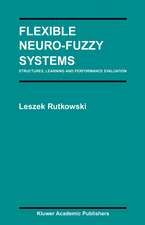Medical Robotics
Autor Achim Schweikard, Floris Ernsten Limba Engleză Hardback – 19 oct 2015
The main idea of the book is to motivate the methods in robotics in medical applications rather than industrial applications. The book then follows the standard path for a robotics textbook. It is thus suitable for a first course in robotics for undergraduates. It is the first textbook on medical robotics.
| Toate formatele și edițiile | Preț | Express |
|---|---|---|
| Paperback (1) | 396.39 lei 6-8 săpt. | |
| Springer International Publishing – 23 aug 2016 | 396.39 lei 6-8 săpt. | |
| Hardback (1) | 364.55 lei 3-5 săpt. | +33.66 lei 5-11 zile |
| Springer International Publishing – 19 oct 2015 | 364.55 lei 3-5 săpt. | +33.66 lei 5-11 zile |
Preț: 364.55 lei
Preț vechi: 455.69 lei
-20% Nou
Puncte Express: 547
Preț estimativ în valută:
69.77€ • 72.57$ • 57.60£
69.77€ • 72.57$ • 57.60£
Carte disponibilă
Livrare economică 24 martie-07 aprilie
Livrare express 08-14 martie pentru 43.65 lei
Preluare comenzi: 021 569.72.76
Specificații
ISBN-13: 9783319228907
ISBN-10: 3319228900
Pagini: 424
Ilustrații: XIII, 424 p.
Dimensiuni: 155 x 235 x 27 mm
Greutate: 0.79 kg
Ediția:1st ed. 2015
Editura: Springer International Publishing
Colecția Springer
Locul publicării:Cham, Switzerland
ISBN-10: 3319228900
Pagini: 424
Ilustrații: XIII, 424 p.
Dimensiuni: 155 x 235 x 27 mm
Greutate: 0.79 kg
Ediția:1st ed. 2015
Editura: Springer International Publishing
Colecția Springer
Locul publicării:Cham, Switzerland
Public țintă
Upper undergraduateCuprins
Introduction.- Describing Spatial Position and Orientation.- Robot Kinematics.- Joint Velocities and Jacobi-Matrices.- Navigation and Registration.- Treatment Planning.- Motion Correlation and Tracking.- Motion Prediction.- Motion Replication.- Applications of Surgical Robotics.- Rehabilitation, Neuroprosthetics and Brain-Machine Interfaces.
Notă biografică
Achim Schweikard received his M.S. in mathematics from Hamburg University in 1985 and his PhD degree in computer science in 1989 from Technical University of Berlin. After his PhD, he joined Stanford University as a research associate in a joint appointment between the departments of computer science and neurosurgery. In this position he pioneered key elements of robotic surgery, among them robotic tumor tracking for radiosurgery,which is now in routine clinical use. Today, a very large number of cancer patients in the entire world have been treated with technologies invented and implemented by him. He joined Technical University of Munich in 1994 as an associate professor of computer science. In 2001, he initiated the 6-year nation-wide German research program on medical navigation and robotics, funded by the German research council. In 2002 he joined Lübeck university as a full professor and founding director of the graduate school of computing in medicine and life sciences at Lübeck, funded by the excellence initiative of the German government. He published more than 100 scientific articles on a wide range of topics in medical robotics. Floris Ernst received the Dipl.-Math. degree (equivalent to M.Sc. in Mathematics) from Friedrich-Alexander-University Erlangen/Nuremberg (Germany) in 2006 and a postgraduate diploma in sciences from the University of Otago (Dunedin/New Zealand) in 2004. In 2006, he joined the Institute of Robotics and Cognitive Systems at the University of Lübeck, where he completed his PhD focusing on motion prediction and correlation algorithms for robotic radiosurgery in 2011. From 2011 to 2012, he worked as a software engineer at an engineering consultancy, specializing on applications in medicine and life sciences. In 2013, he returned to the Institute of Robotics and Cognitive Systems at the University of Lübeck for his habilitation, which he completed in 2015. He is currently working as a senior research associate, with researchfocused on algorithms and technologies for motion management in radiation therapy and related fields, teaching classes in robotics and artificial intelligence. He is author and co-author of more than 50 scientific articles and internationally peer-reviewed conference proceedings.
Caracteristici
Presents an in-depth survey of medical robotics that appeals to graduate-level students and researchers Incorporates cutting-edge research in the field of target tracking, treatment planning, special kinematics and motion compensation Examines state-of-the art robots, including the DaVinci system, the CyberKnife, motorized C-arms and operating microscopes, as well as stereotactic frames




























